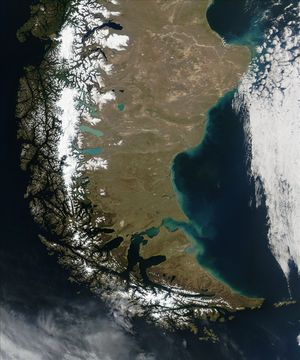
Sheep farming techniques are changing in Argentina in order to sustain and rebuild the grasslands. New methods in pasture rotation and grass farming are hoping to restore the area and are being supported by the clothing company Patagonia and organizations such as the Food and Agriculture Organization, The Nature Conservancy and National Institute for Agricultural Technology.
Background[edit | edit source]
Approximately 70 percent of the world's agricultural area is grassland. A study by the United Nations Food and Agriculture Organization states that grasslands have a "high" potential for carbon mitigation because of the area covered.[1] Grasslands also generate benefits such as improving food security, biodiversity and water conservation. Rangelands are the world's largest land use type and represent more than 60 percent of the total land in 28 countries.[2] The livelihoods of almost one billion people depend on grasslands.[3] Improved management of grasslands is needed to sustainable development and food production.
Almost 75 percent of all sheep in Patagonia are Merino.[4] Flocks dominate the provinces of Neuquén, Río Negro, Chubut and northern Santa Cruz. On these farms, wool sales can represent up to 80 percent of total farm income.[5] Grasslands in southern Santa Cruz and northern Tierra del Fuego have a higher production of plants that can be foraged and are more suitable for meat production. In this area, Corriedale sheep that were introduced in the mid-twentieth century have been very successful. Many meat breeds (such as Texel, Southdown and Hampshire Down) are being introduced to improve lamb traits such as growth rate and low fat.[6]
Merino wool is considered to be some of the finest wool in the world. It is exceptionally soft, naturally breathable and warm even when wet. The wool resists wrinkling, odors and flame retardant. It is one of the largest exports from Argentina.[7]
Issues[edit | edit source]
While overgrazed farms are likely to produce more and finer wool, any nutritional restrictions decrease lambing rates and survival of adult sheep. This decreases the overall meat sales of a sheep farm. Overgrazing in arid areas can cause a decrease in reproduction and survival past the equilibrium point of the flock, causing sheep population numbers decline. A properly managed sheep farm sells 24 to 44 percent of the herd annually (depending on the natural environment), whereas sales from overgrazed farms range from zero to 15 percent.[8] Overpopulation of sheep to produce more, along with the region's harsh weather conditions, have exhausted natural grasslands in the Patagonia region of Argentina, accelerating a desertification process.
Solutions[edit | edit source]
Farmers in the region have begun rotating herds between pastures to allow regrowth. The rotation allows for the regeneration of native plant species and helps prevent over-grazing and desertification. There is also a movement of converting seed farming to grass farming.[9]
The Nature Conservancy is collaborating to use satellite technology and on-the-ground field work to map the vegetation and wildlife distribution.[10] The National Institute for Agricultural Technology in Argentina, with the aid of GTZ (Deutsche Gesellschaft für Technische Zusammenarbeit), developed evaluation methods for ranges based on satellite imagery and field measurements, which provide information for grazing plans.[11] The Nature Conservancy will also identify priority areas for conservation and find ways to protect those areas. It is developing and implementing management methods that favor the natural conditions and local flora and fauna.
Patagonia Inc. has teamed with The Nature Conservancy and Ovis XXI to promote the conservation of natural grasslands. Patagonia committed to buy sustainable wool from Ovis XXI as long as the organization certifies that the producers are keeping and restoring their natural grasslands. Ovis XXI instructs the producers along with The Nature Conservancy.[12]
References[edit | edit source]
- ↑ Food and Agriculture Organization: Grasslands http://www.fao.org/fileadmin/templates/agphome/documents/climate/FinalUNFCCCgrassland.pdf
- ↑ Food and Agriculture Organization: Grasslands http://www.fao.org/fileadmin/templates/agphome/documents/climate/FinalUNFCCCgrassland.pdf
- ↑ Food and Agriculture Organization: Grasslands http://www.fao.org/fileadmin/templates/agphome/documents/climate/FinalUNFCCCgrassland.pdf
- ↑ Food and Agriculture Organization: Sustainable Sheep Farming http://www.fao.org/docrep/008/y8344e/y8344e0a.htm
- ↑ Méndez Casariego, H. 2000. Sistema de soporte de decisiones para la producción ganadera sustentable en la Provincia de Río Negro (SSD-Río Negro). INTAGTZ. Centro Regional Patagonia Norte. EEA Bariloche. EEA Valle Inferior. Proyecto Prodesar
- ↑ Mueller, J. 2001. Mejoramiento genético de las majadas patagónicas. pp. 211-224, in: P. Borrelli and G. Oliva (eds). Ganadería ovina sustentable en la Patagonia Austral. Rio Gallergos, Argentina: Prodesar/ INTA-Centro Regional Patagonia Sur.
- ↑ Merino Wool Baselayers http://www.patagonia.com/us/patagonia.go?assetid=8514
- ↑ Borrelli, G., Oliva, G., Williams, M., Gonzalez, L., Rial, P. & Montes, L. (eds). 1997. Sistema Regional de Soporte de Decisiones. Santa Cruz y Tierra del Fuego. Proderser (Proyecto de Prevención y Control de la Desertificación en Patagonia), Río Gallegos, Argentina
- ↑ CNN http://www.youtube.com/watch?v=bMMFJnWcH_s
- ↑ The Nature Conservancy: Sustainable Sheep http://web.archive.org/web/20151028000244/http://www.nature.org/ourinitiatives/regions/southamerica/argentina/explore/sustainable-sheep-argentina.xml
- ↑ Food and Agriculture Organization: Sustainable Sheep Farming http://www.fao.org/docrep/008/y8344e/y8344e0a.htm
- ↑ TreeHugger.com: Patagonia Launches Groundbreaking Sustainable Wool Program In Argentina http://www.treehugger.com/corporate-responsibility/patagonia-launches-groundbreaking-sustainable-wool-program-in-argentina.html

